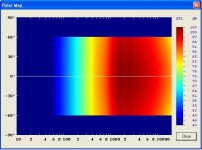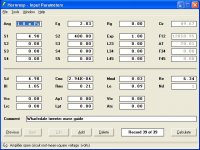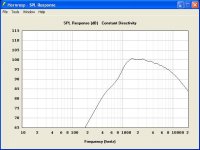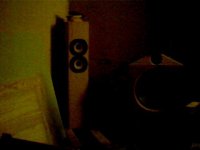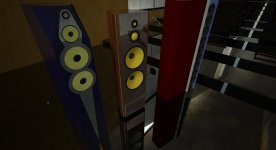Hi, Im building a pair of TMM Tline speakers the first one is built but i'm now working on the tweeter part. I'd Like to place the 1inch tweeter in a constant directivity waveguide so i've been working with hornresp to see if i can get the correct profile. There's an elderly gentleman I know who will be able to turn the guides on his lathe.
Here are some screenshots of what i've come up with. Am I on the right track and if not could someone advise please.
Here are some screenshots of what i've come up with. Am I on the right track and if not could someone advise please.
Attachments
Hi,
I am doing something similar, but haven't got around doing it.
If I were to get the response you are geting I would be using an equalizer and make it flat, there measure the directivity 0,15,30,45deg Use a DSP to equalise is much faster.
A passive equalizer may include a parallel cap and resistor connected in series with the tweeter.
I am doing something similar, but haven't got around doing it.
If I were to get the response you are geting I would be using an equalizer and make it flat, there measure the directivity 0,15,30,45deg Use a DSP to equalise is much faster.
A passive equalizer may include a parallel cap and resistor connected in series with the tweeter.
It looks like you're using Hornresp to put an exponential horn on the tweeter. I don't think wave guides are the same as horns, so that may be part of the problem you're seeing. There is also some missing data in your model.
what's missing and ill try and fill it in
what's missing and ill try and fill it in
Sorry, my mistake. Nothing missing. I'm not familiar with the design of wave guides, so I can't really help there, but I assume Hornresp is designed for horns and not wave guides. Using the program, the response flattens out if you make the horn longer. How did you calculate the mouth area?
I did it in the past with a circular waveguide that followed the orriginal JBL CD flare and a starting angle of 100 degrees IFRC. Unfortunately the high symmetry gave it a pretty good dip (mouth reflection) on axis.
Your frequency response looks plausible to me (assuming you don't get a mouth dip). You will get a lot of gain towards the low end due to controlling directivity and better loading. At the high end your tweeter's directivity would already be close to the waveguide's so the axial gain diminishes.
Good Luck,
David S.
Your frequency response looks plausible to me (assuming you don't get a mouth dip). You will get a lot of gain towards the low end due to controlling directivity and better loading. At the high end your tweeter's directivity would already be close to the waveguide's so the axial gain diminishes.
Good Luck,
David S.
Hi, Im building a pair of TMM Tline speakers the first one is built but i'm now working on the tweeter part. I'd Like to place the 1inch tweeter in a constant directivity waveguide so i've been working with hornresp to see if i can get the correct profile. There's an elderly gentleman I know who will be able to turn the guides on his lathe.
Here are some screenshots of what i've come up with. Am I on the right track and if not could someone advise please.
This arrangement has a constant 120 deg beam width out to about 18,000 Hz. Is that what you're looking for?
these are for nearfield use with an acute 45 degree listening angle because of this i dont want the tweeters to beam. hopefully this is the correct method (im still a bit of a noob).
This all started with the design of a transmission line for my son's birthday. It has now evolved into 4' high dual 6/5" woofer t lines flat to 35hz with the tweeter filling in form approx 3khz upwards.
This all started with the design of a transmission line for my son's birthday. It has now evolved into 4' high dual 6/5" woofer t lines flat to 35hz with the tweeter filling in form approx 3khz upwards.
these are for nearfield use with an acute 45 degree listening angle because of this i dont want the tweeters to beam. hopefully this is the correct method (im still a bit of a noob).
This all started with the design of a transmission line for my son's birthday. It has now evolved into 4' high dual 6/5" woofer t lines flat to 35hz with the tweeter filling in form approx 3khz upwards.
Well, I don't understand wave guides very much, but it looks like, based on the Hornresp simulation, that only dogs will have a problem with your arrangement. You'll have to make sure Woofie sits in the sweet spot in order for him to get good imaging.
Should i aim for a lower directivity at high frequencies with more of a boost in response around fs?
The design as it is is very very shallow and not like the other waveguides i've seen is there a reason for this?
Well, it does look like the typical dome tweeter wave guide I've seen on commercial studio monitors, for example. They are very shallow. It seems that the simulation program is telling me that the less this is like a horn, the better the constant directivity. So, try S2 = 150 and EXP = .75.
I've tried a smaller s2 but directivity suffers. I've also tried oblate spheroid configurations the average dB level was higher out to 20 kHz but there seemed to be a mess of +- dB dips which I think would be very hard to equalise out. I do think that a rolling off high frequency response may be less difficult to tame as i can just boost the highs and still retain the off axis directivity.
My main concern at the moment having these accurately created.
My main concern at the moment having these accurately created.
i dont want the tweeters to beam.
If I understand correctly, it is the slowly expanding shape of horns that causes the highs to leave the walls and beam, compared to waveguides that tend to resemble cones with a shorter roundover near the throat.
I've also tried oblate spheroid configurations
Hornresp will estimate these but there has been some contention as to the accuracy. It seems that the math that Hornresp uses comes into question when a wave reaches around the corner (can't see the throat anymore).
Personally, I'd encourage you to keep using Hornresp, just to not get caught up in minor details unless they can be explained.
Horn and waveguide are the same thing. Actually, I'd just stick to the term horn since waveguide is a marketing term more than an accurate engineering term, but whatever. There are only variations of horn profiles, some more popular than others at any given time and some better suited for certain tasks than others. Whether hornresp accurately models all horn profiles I can't say, but if not it isn't because a "waveguide" is some fundamentally different thing. It's just a different word, though in popular forum use it seems to be used more often to describe cd horns than not.
Horn and waveguide are the same thing. Actually, I'd just stick to the term horn since waveguide is a marketing term more than an accurate engineering term, but whatever.
I agree that the terms are ambiguous and to some degree interchangeable, but why not encourage them to be redefined? I disagree that either is a marketing term despite the term 'waveguide' being defined by someone who sells them.
A 'waveguide' is clearly a subset of horns as a waveguide shapes dispersion and minimises distortion, and forgoes the acoustical transformation which is the common purpose of ordinary horns. In fact, waveguides specifically avoid it where it would cause distortion.
- Status
- This old topic is closed. If you want to reopen this topic, contact a moderator using the "Report Post" button.
- Home
- Loudspeakers
- Multi-Way
- Help with Silk Dome Tweeter Waveguide
